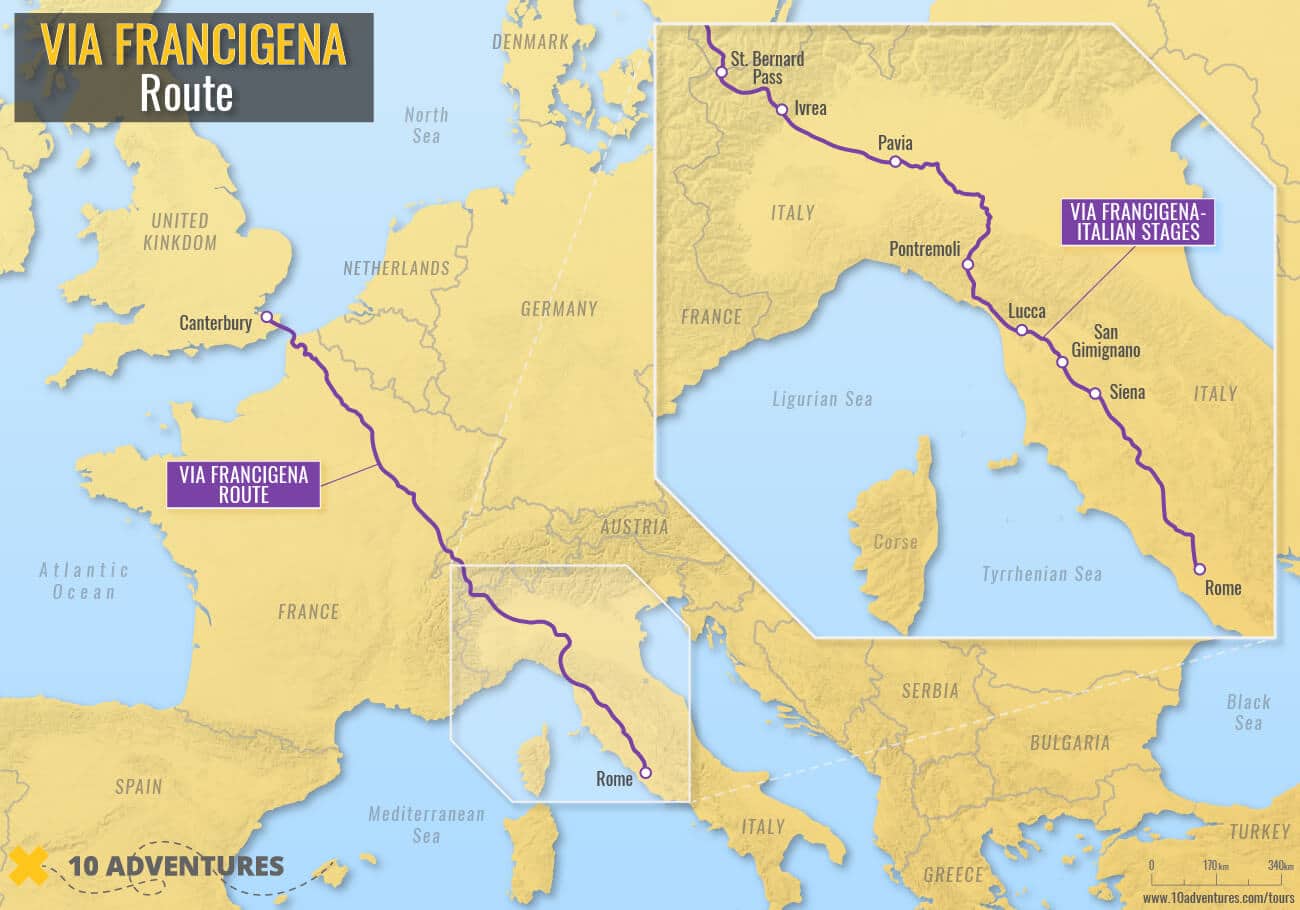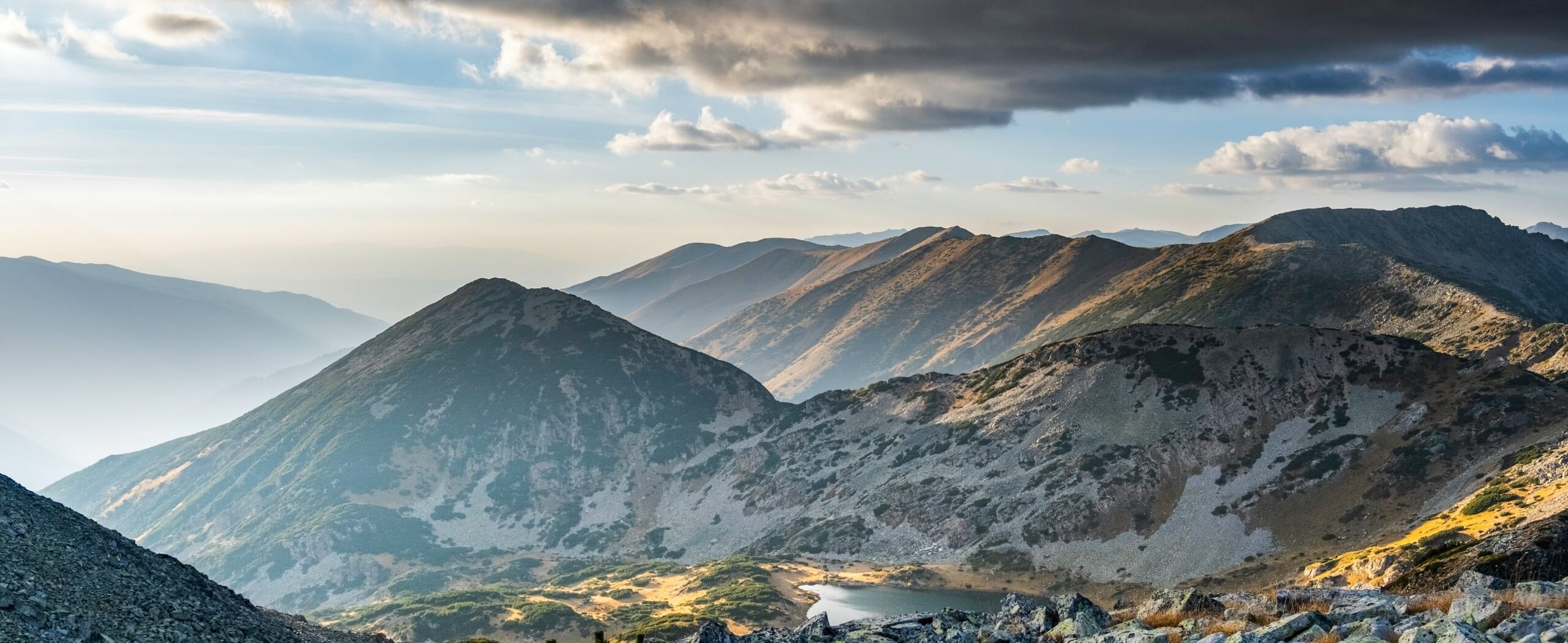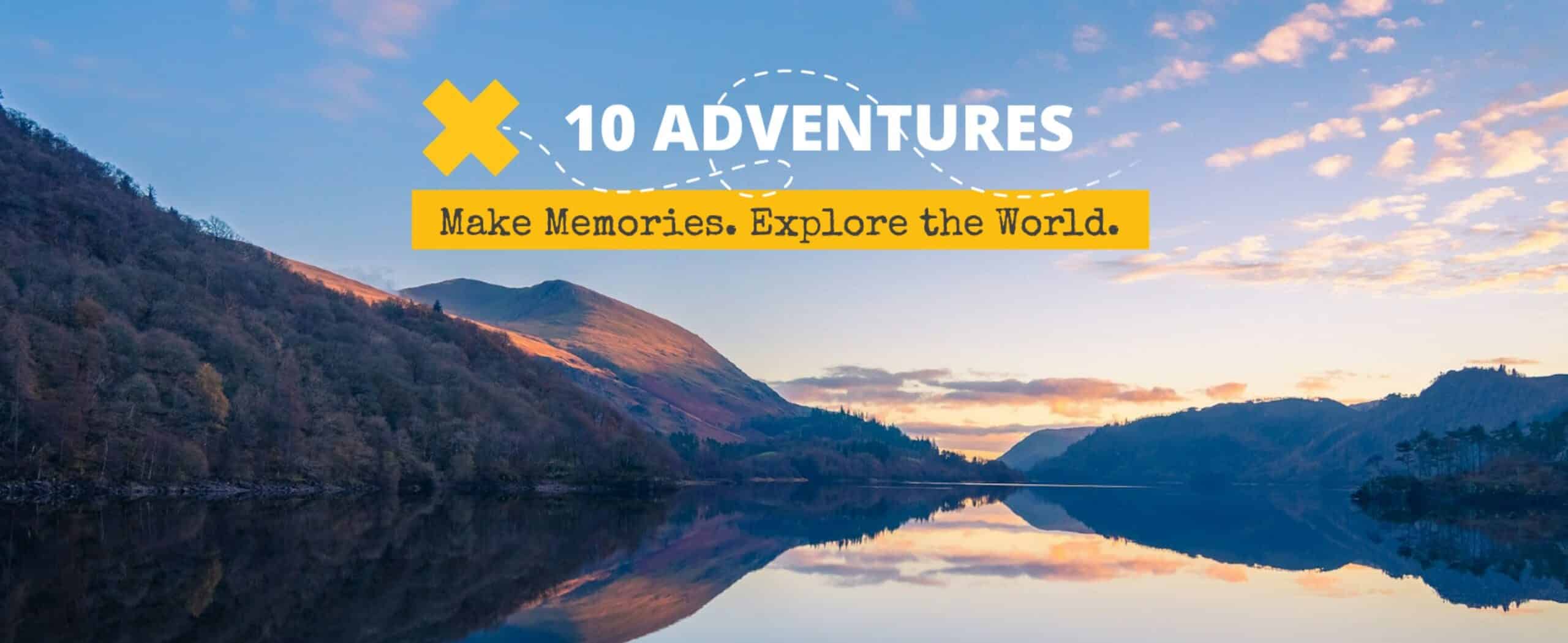The Via Francigena might not be what immediately springs to mind when you think of epic pilgrimages – that honour is generally held by the well-known Camino de Santiago – but it truly is an incredible walking route in its own right. This ancient trail winds from Canterbury in England all the way to Rome, taking you on a journey through the heart of Europe and across the picturesque Italian countryside. The Via Francigena has a quiet magic all its own—a path that combines history, culture, and the beauty of Italy in one unforgettable trek.
So what makes the Via Francigena special? It’s the road less traveled, literally. You won’t encounter the same crowds as the Camino, allowing for a more personal experience, and the landscape is equally mesmerizing—think rolling vineyards, medieval villages, and iconic Italian landscapes at every turn. It’s a pilgrimage that immerses you in Italy’s incredible history, from ancient Roman roads to the hilltop towns of Tuscany, all the way to the iconic heart of Rome itself.
If you’re considering a long-distance trek but want something a bit different, the Via Francigena might be the perfect path. This isn’t just an alternative to the Camino—it’s a journey that stands on its own, offering not only a test of endurance but also a rich cultural adventure. With Italy’s culinary delights, historic sites, and warm hospitality, the Via Francigena might just be the pilgrimage you’ve been searching for.

An Overview of the Via Francigena Route
The Via Francigena is often divided into 79 stages, but many travelers focus on walking the 1,000 km stretch within Italy, starting at the Great St Bernard Pass in the Alps and continuing south to Rome. This segment of the route is usually tackled over several weeks, although you can take it as a slower, more contemplative journey or even complete it in smaller sections over time.
As you walk the route, you’ll pass through a wide range of landscapes—from the mountainous terrain of Aosta Valley to the picturesque vineyards of Tuscany. Key stops include historic towns such as San Gimignano, Viterbo, and Siena, each rich with history, art, and Italian charm. The journey culminates in Rome, offering a profound sense of accomplishment as you reach the Eternal City.
For some travellers, walking the Via Francigena isn’t the optimal way to experience the Italian countryside. For those who would rather travel at a quicker pace, but still feel immersed in the atmosphere of la dolce vita, some stages of the Via Francigena can be completed by bike, such as the stretches from Parma to Siena, and Siena to Rome.
Route Highlights:
The Great St Bernard Pass – Start your Italian journey in the majestic Alps, where towering peaks set the scene for the adventure ahead.
Aosta Valley – Step into a land of castles and Roman ruins nestled amid the mountains.
Tuscany – Wander through Tuscany’s rolling hills, dotted with vineyards and cypress trees, and stop in medieval towns like San Gimignano and Siena.
Lazio – The final stretch before reaching Rome, where pilgrims have walked for centuries, with Rome’s spires rising in the distance.
One of the great things about the Via Francigena is that each region along the route has its own flavor, from the Swiss-Italian feel of Aosta Valley to the golden hills of Tuscany. And along the way, you’ll meet other pilgrims, some retracing centuries-old footsteps, others seeking a modern adventure.

Q&A with 10Adventures Founder Richard Campbell
Having recently returned from completing the Via Francigena with his wife, 10Adventures Founder Richard Campbell has emerged from his first pilgrimage with a newfound appreciation for this type of adventure, as well as a few tips and tricks learned along the way. From the sharing inspiration behind their trip, to things you would only know after completing the route, dive into this exclusive Q&A to discover what awaits on the path ahead.
Q: Your recent walk along the Via Francigena was your first pilgrimage experience. What made you decide to do it now at this stage of your life?
A: We’ve been busy raising three kids for the last 12+ years, but this has always been on our bucket list. My wife and I wanted to take our first trip with just the two of us since before we had children, and this just felt like the right time to experience the Via Francigena. We liked the idea of doing an ancient pilgrimage, but I have also walked and cycled in Tuscany, and I know how fantastic it is. I really wanted to share some of my favourite parts together, and this seemed like the perfect opportunity to do it.
Q: You’ve trekked a number of long-distance routes in the past. How does a pilgrimage compare to other long-distance walking experiences?
A: It’s great, but different. The serenity and one-on-one time remain, as do the shared experiences, the beautiful views, and wonderful meals. But on mountain walks you can feel remote and isolated, whereas on this walk you’re going through villages and towns every day. I think on mountain walks there is always a feeling of scarcity (what food you’re carrying, what will be at the hut), whereas on this walk we didn’t have that same worry, which was a nice change.
Q: In your mind, what separates the Via Francigena from other popular pilgrimages like the Camino de Santiago in Spain or the St. Paul Trail in Türkiye?
A: I think what makes the Via Francigena special, especially the portion from Lucca to Rome, is that it goes through charming villages and beautiful countryside throughout the duration of the route. In addition, you get to stay in beautiful towns, eat great food, and have an overall luxurious experience. It’s also still relatively unknown, getting about 1% of the traffic of the Camino de Santiago. This was a big deciding factor for us, as the villages we went through are still living villages, and quite authentic. As an example, on one day of walking there were eleven other travellers walking. We had all started in different places, some had come from Canterbury, others the Aosta Valley, and others joined in Siena and Montefiascone. For such a small collection of people from different areas, it was incredible to see how everyone converged on the same place.

Q: People often underestimate pilgrimages, as they generally pass through towns and villages, rather than the backcountry. Any tips or insights from your journey on how to best prepare for a pilgrimage?
A: So I broke every rule, and totally underestimated the journey! I brought new boots and new orthotics on this trip. I thought because we’d been backpacking hard multi-day trails in the Rockies in the summer that this would be a piece of cake, and I haven’t had blisters in years. I was wrong. Some days were very hard, with one 33km day featuring around 1,300m of elevation gain! I had to deal with excruciating blisters, and hadn’t even brought my normal blister kit, so couldn’t treat them effectively. On top of this, I think we simply tried to go too fast. I wish I had taken two or three half days, just to give us more time to explore local areas.
Q: Compared to other styles of walking adventures, pilgrimages are often closely tied with the culture of the region. Whether it was a meal, point of interest, or an interaction with locals, what was the most memorable cultural element of your time walking the Via Francigena?
A: That’s easy. The food! But a close second was the history. We were going through villages and towns that had incredible visual history, and when you actually began exploring it, it was amazing to think what had happened in the places we were walking through
Q: The Via Francigena passes through many beautiful historic towns, but also culminates with an arrival in the eternal city of Rome. Which stages were the highlight of the itinerary?
A: So the obvious towns of Lucca, San Gimignano, Siena, and Rome were great, but they were also the busiest sections. I think the nicest parts were the towns I didn’t know. Colle di val d’Elsa was spectacular, and Sutri was surprisingly charming. A favourite memory was the tiny town of Gambassi Terme, and taking an evening drink while the rest of the town was also out front of the only bar in town, looking over the Tuscan countryside.
Q: Rest days are common on long-distance walking tours. Was there ever a point during your trip that you wished you had an extra day, whether to let your body recuperate or simply to explore the area?
A: Yes, this was a huge mistake we made while planning. I thought it would be easy because it wasn’t as mountainous as the Rockies, but it was much more challenging than I expected.

Q: Who is the ideal traveller to walk the Via Francigena?
A: If you like good food, history, and wonderful countryside views, then I think the Via Francigena is the perfect trip for you. I think it’s also a unique pilgrimage for somebody who has already done a Camino de Santiago or two and wants to try a similar experience in a different destination.
Q: Any pieces of advice you would give to someone looking to walk the Via Francigena for the first time?
A: Go slower, as it is such an enjoyable trip. We got too focused on completing it, but we would have been better off going slower to better experience the surrounding areas, especially during the last few days.
Q: Do you have plans to set out on a future pilgrimage? Maybe a family Camino?
A: Yes, we want to walk the Camino Portuguese coastal route with our children, and let them enjoy a long walking trip without having to bring tents and sleeping bags. They really only know backpacking in the Rockies, and are really curious about this type of trip. Not having to carry much gear, and being able to stop in restaurants to eat, and also getting ice cream if it’s hot out is really appealing to them.

Ready to Walk the Road Less Traveled? Start Your Via Francigena Adventure
The Via Francigena isn’t just a walk through Italy—it’s an immersive journey into Europe’s rich past and Italy’s present-day beauty. From the quiet camaraderie of fellow travelers to the mesmerizing landscapes and unforgettable moments, this trek is an experience like no other. Whether you’re drawn to its spiritual history, its cultural allure, or simply the joy of walking in breathtaking landscapes, the Via Francigena offers an adventure that will stay with you for a lifetime.
Thinking of lacing up your boots? Now is the perfect time to book a Via Francigena tour. With the support of 10Adventures, you can choose a self-guided tour that will give you the freedom to go at your own pace and enjoy this remarkable journey with local knowledge and support. From accommodations to daily route planning, we make it easy for you to focus on what really matters: soaking up the beauty, culture, and spirit of Italy.
Join the growing community of pilgrims and explorers who have discovered the magic of the Via Francigena. Let us take care of the details, so you can focus on the journey. Book one of the Via Francigena tours below with 10Adventures and experience Italy in a way that only a long-distance trek can offer.
Walk the Via Francigena’s Italian Stages:
Via Francigena 1: Saint Bernard Pass to Ivrea
Via Francigena 2: Ivrea to Pavia
Via Francigena 3: Pavia to Fidenza
Via Francigena 4: Fidenza to Pontremoli
Via Francigena 5: Pontremoli to Lucca
Via Francigena 6: Lucca to Siena
Via Francigena 7: Siena to Montefiascone
Via Francigena 8: Montefiascone to Rome



Comments